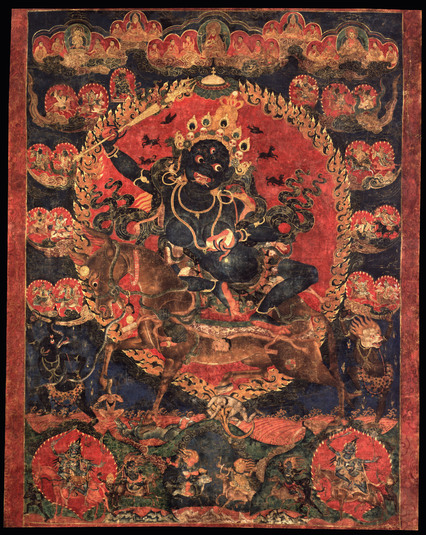
Item: Shri Devi (Buddhist Protector) - Magzor Gyalmo
| Origin Location | Tibet |
|---|---|
| Date Range | 1400 - 1499 |
| Material | Ground Mineral Pigment on Cotton |
| Collection | Private |
Shri Devi, Magzor Gyalmo (Tibetan: pal den lha mo, mag gyi zor le, gyal mo. English: Glorious Goddess, the Queen who Repels Armies, or the Queen who has the power to turn back armies. Sanskrit: Shri Devi, Yakshi Remati): belonging to the larger class of enlightened protector deities known as Shri Devi. Magzor Gyalmo is regarded as a wrathful emanation of the peaceful goddess Sarasvati, popular in Hinduism and Buddhism. This is one of two early examples of Magzor Gyalmo in painting.
Video: Two Early Magzor Gyalmo Paintings (HAR on Patreon)
"... Shri Devi Remati, Queen who Repels Armies, riding a mule, blue-black in colour, with one face and two hands, having bared fangs and gnashing down on a human corpse. Possessing three round red eyes, and the forehead furrowed into a frown, brown hair flowing upward with licks of flame and smoke issuing forth. The right ear is adorned with a poisonous snake and the left with a lion, crowned with five dry human skulls and a necklace of fifty blood dripping wet [heads] strung with intestines. ... having a lower garment of tiger skin, a snake belt and necklace, and the like. The right hand holds to the sky a sandalwood stick marked with a vajra. The left holds to the heart a mustard seed and blood filled skullcup. ... At the navel is a sun and at the crown of the head a crescent moon; above the head is a peacock parasol canopy." (Sharchen Champa Kunga Tashi 1558-1603).
Northern Buddhism often prides itself on stating that it has no deities, a statement that does not appear obvious. What is meant here is that the Buddhism of India has created no deities for itself. Implying that it has appropriated deities from other religions. This is a statement from deep within Buddhism and as to proving how valid it is will require careful examination. Based on similarities between Hindu and Buddhist literature and their origin myths, the Glorious Goddess, is undeniably related to the Hindu mother goddess Kali, the wife of Shiva in a wrathful form.
The Glorious Goddess is understood as a class of female protector deity that includes many forms and many different variations on the early origin myth. Some claim that there are twenty-one in number attested to in popular prayer; others say that some of these forms are indigenous to the Himalayas and Tibet. Relying on ancient Tibetan texts, possibly of Indian origin, the Glorious Goddess has a list of one hundred names. Portrayed with four arms, she is considered the principal and original form of the goddess, similar to the Hindu goddess Kali.
The Queen who Repels Armies, appearing with just two arms, is another form within this class. Based on her specific origin myth she is said to be the fearsome manifestation of the Hindu goddess Sarasvati, popular in Hinduism and Buddhism. In the Bon religion Queen of the World is similar to the Buddhist and Hindu forms in both appearance and function.
Jeff Watt 5-2003
Exhibition: Female Buddhas at RMA
Thematic Sets
Buddhist Protector: Shri Devi, Magzor Gyalmo Main Page
Buddhist Protector: Shri Devi, Magzorma (Masterworks)
Subject: Protector Deities, Tibetan (Prior to 17th Century)
Buddhist Deity: Shri Devi, Magzorma with Retinue
Buddhist Protector: Shri Devi (Early Works)
Buddhist Protector: Shri Devi Earrings
Buddhist Protector: Shri Devi, Magzor Gyalmo (Early Paintings)
Buddhist Protector: Shri Devi Art History
Collection: Private 1
Buddhist Protector: Shri Devi Main Page
Tradition: Gelug Protectors
Buddhist Deity: Deities (Female)
Buddhist Protectors: Enlightened (Female)

